Кульчицкая Надежда Львовна учитель моу «Алаботинская сош» Русско-Полянского муниципального района телефон №3-51-64 Реализация воспитательного потенциала на урок
| Вид материала | Урок |
- Л. И. Рогуля моу сош №4 г. Белгорода Учитель географии Повышение воспитательного потенциала, 103.66kb.
- Змановская Надежда Николаевна, Учитель литературы, моу: сош п. Горноправдинск урок, 121.81kb.
- Программа и дидактические материалы предметно-ориентированного курса по выбору для, 141.72kb.
- Дьякова Надежда Георгиевна, учитель технологии моу сош с. Дьяковка Саратовской области,, 62.6kb.
- Казюкина Валентина Николаевна учитель истории и обществознания. Моу сош с. Киселевка, 242.1kb.
- Урок на тему: «Тверские земли в ХIV веке», 116.03kb.
- Организационно-педагогические условия функционирования педагогической технологии исследования, 304.79kb.
- Жизнь и деятельность Приамурских генерал-губернаторов, 240.73kb.
- Тихонова Надежда Михайловна учитель географии и биологии моу старо-Матакская сош алькеевского, 110.83kb.
- Моу «Берсеневская сош», 58.02kb.
Pupil 1: We offer fascinating sightseeing tours to the most interesting places in Omsk and Omsk region.
Omsk is one of the oldest cities in Western Siberia. A bus sightseeing tour "On the wild bank of the Irtysh River" offers a brief survey of Omsk history of 18-20th centuries and includes all main attractions of the city.
You'll visit the site of the first wooden Omsk fortress built in 1716 in order to guard Russian Southern borders from the nomads; you'll also see Tobolskie and Tarskie gates - one of the first stone buildings in Omsk.
In the beginning of the 19th century Omsk becomes an administrative centre of Western Siberia and the buildings of that period - the Commandant's House, the Cadet School, St. Nicholas Cathedral - convey the atmosphere of the epoch up to the present moment.
Rows of the newly built Moscow commercial offices and shops on Lyubinsky Avenue marked the beginning of the 20th century.
The exposition of the Museum of Local Lore will tell you about the times when first men trod on the Irtysh-side; you'll see ancient staff belonging to the first settlers, objects of their cult and life that reflect Siberian habits and beliefs.
In course of the trip you'll also learn about the celebrities that were born, have lived or ever visited our city.
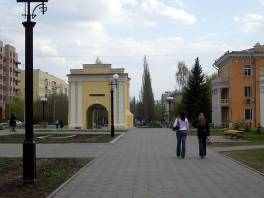
P
Tara gates
upil 2: The wooden fort of Omsk was erected in 1716 to protect the expanding Russian frontier, along the Ishim and the Irtysh rivers against the Kyrgyz nomads of the Steppes. In the late 1700s, stronger works of brick were erected on the right bank of the Om; of these, the original Tobolsk and the restored Tara gates still stand, along with the original German Lutheran Church, an armory, a military jail, and commandant's house. Tarskaya street, the historical centre of the Omsk city. In the background, are visible the Tarskiye (or Tara) gates, an arc that was part of the Omsk fortress.

Tobolsk gates

Tobolsk gates

German Lutheran Church
A military jail

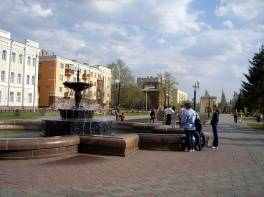
An armory
Tarskaya street
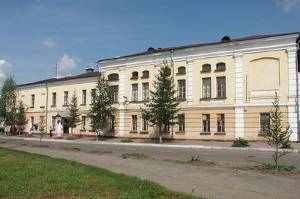
Commandant's house.
P
Commandant's house.
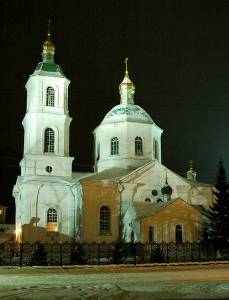
The Cathedral of the Exaltation of the Cross
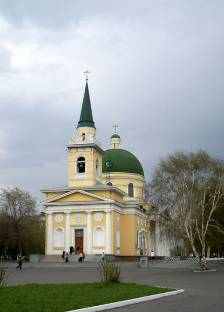
Cathedral of St Nicholas
upil 3: In the 1800s and the early 1900s, Omsk became the administrative center of Western Siberia and the Steppes (Kazakhstan), acquiring a few churches and cathedrals of various denominations, mosques, a synagogue, the governor-general's mansion, a military academy. Among them the Cathedral of the Exaltation of the Cross (Krestovozdvizhenskij church) situated in Tarskaya Street exists already for 130 years. The building signifies a great interest of the architects of the second half of the 19th century to historical styles. The silhouette of the domes and church-tower makes one recall the shapes of the Baroque structures. This impression is more intensified when the Cathedral in recent times was restored with gold.
A
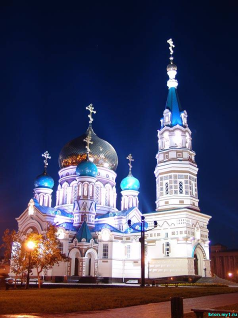 nother area of interest is Nikolsky prospekt/Krasnykh Zor Street, where a line of merchants' wooden houses still stands. The street leads to the Neoclassical Cathedral of St Nicholas, which was commissioned by the Cossacks, designed by Vasily Stasov and consecrated in 1840. It contains various relics of the Siberian Cossacks. The interesting fact is that it>
nother area of interest is Nikolsky prospekt/Krasnykh Zor Street, where a line of merchants' wooden houses still stands. The street leads to the Neoclassical Cathedral of St Nicholas, which was commissioned by the Cossacks, designed by Vasily Stasov and consecrated in 1840. It contains various relics of the Siberian Cossacks. The interesting fact is that it> T
The Dormition Cathedral
he largest and most opulent church in the city is the Dormition Cathedral, a pompous five-domed building in the Russian Revival style, consecrated in 1896, blown up by the Soviets, and meticulously restored in the early 2000s.
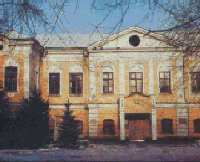
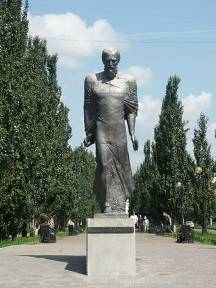 Pupil 4: It was during the mid-1800s that Dostoevsky lived and wrote in exile here. Fate of the world famous writer Fyodor Dostoyevsky is closely connected with our city. Dostoyevsky spent 4 years (1851-1855) in Omsk stockade having been condemned to penal servitude. During the years of his exile Dostoevsky started writing some of his famous novels, including "Notes from the Dead House".
Pupil 4: It was during the mid-1800s that Dostoevsky lived and wrote in exile here. Fate of the world famous writer Fyodor Dostoyevsky is closely connected with our city. Dostoyevsky spent 4 years (1851-1855) in Omsk stockade having been condemned to penal servitude. During the years of his exile Dostoevsky started writing some of his famous novels, including "Notes from the Dead House".B
The Guardhouse
Monument to Dostoyevsky
Monument to Dostoyevsky
uildings of the Guardhouse can make you feel the gloomy fortress atmosphere even at present, in the beginning of the 21st century. Nowadays “The Literature Museum” called in his name shows genuine objects of those days and narrates about Dostoyevsky's friends in Omsk.
P
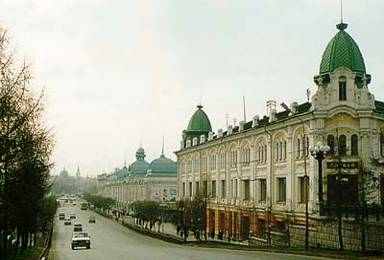
Lyubinsky avenue
upil 5: The new boom began with the construction of the Trans-Siberian railway in 1890s, when the merchants flocked to the city on the rail/river junction. Many trade companies opened stores and offices here, building an elaborately decorated district of the city. Foreign powers, including the British, Dutch and Germans, opened consulates to represent their commercial interests. The pinnacle came with the lavish Siberian Exposition of Agriculture and Industry in 1910, for which a complex of buildings and fountains was constructed. In line with the popularity of World Fairs of the day, the exposition influenced observers to foretell the wonders of the "Chicago of Siberia". Many of the period's buildings survive, and the architecture gives the city center a distinguished historical Siberian town flavor. Among them Lyubinsky avenue. By the year of 1905 the high street of old Omsk - Lyubinsky Prospect (avenue) had been finally formed. No doubt, the leading role of its architectural complex belonged to the Moscow rows of stalls (designed by O.Dessin). Various Russian manufactory Joint-stock Companies (including P.Ryabushinsky, S.Morozov, the Nosovs) accomodated their goods for wholesale trade there.
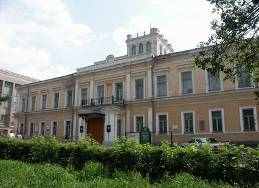
P
Governor-General Palace
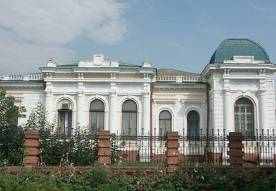 upil 1: One of the important pages in the history of our city is the Civil War. From June 1918 to November 1919 Omsk was a residence of the Supreme Governor of Russia - Admiral Alexander Kolchak who proclaimed Omsk the capital of Russia. Having come to power, Kolchak summoned an Extraordinary Assembly and a Senate.
upil 1: One of the important pages in the history of our city is the Civil War. From June 1918 to November 1919 Omsk was a residence of the Supreme Governor of Russia - Admiral Alexander Kolchak who proclaimed Omsk the capital of Russia. Having come to power, Kolchak summoned an Extraordinary Assembly and a Senate. T
Batyushkov's House
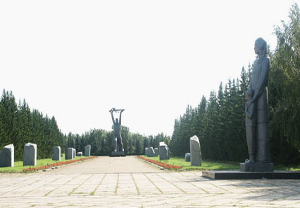 here remained some buildings connected with his name: the Governor-General Palace and Batyushkov's House where Kolchak lived for some time and the House of Law Establishments.
here remained some buildings connected with his name: the Governor-General Palace and Batyushkov's House where Kolchak lived for some time and the House of Law Establishments. D
The memorial complex “Victory Park”
uring World War II Omsk played a great role. Thousands of Omsk citizens fought against Nazi Army and hundred of thousands worked at many industrial enterprises evacuated to Omsk from the western part of the Soviet Union, thus bringing closer the Victory Day. In honor to all soldiers of Red Army the memorial complex “Victory Park” was erected.
Pupil 2: Omsk is a great cultural center of the West-Siberian Region of Russia. More than one thousand monuments of history, culture and archaeology are on the territory of our region.
T
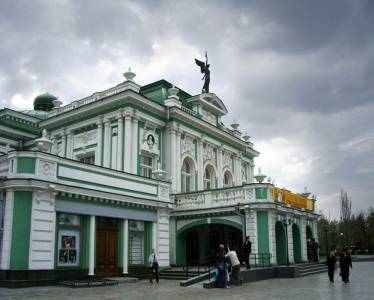
The Omsk State Academic Drama Theatre
he Omsk State Academic Drama Theatre is one of the oldest theatres. Its building – a pearl of Siberian baroque – was built 1905. The famous Paris Grand-Opera had served as a prototype for a great number of theatre buildings in Russia. The Omsk Drama Theatre was among them. In ten years the edifice was topped by the statue of a "Winged Genius" by sculptor V.Vinkler.
C
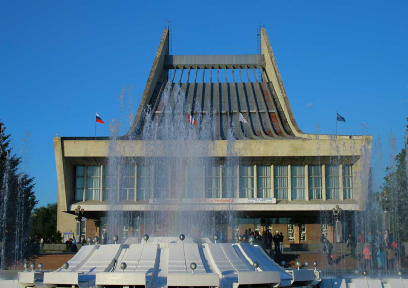
The Omsk State Music Theatre
itizens of Omsk are proud of the Omsk State Music Theatre. In its repertoire all the genres of musical art are represented: opera, ballet, operetta, musical, vaudeville and others. The producers from the USA and Austria realized the opera performances and musicals on its stage.

The Puppet Theatre “Arlekin”
The most outstanding event in cultural life of Omsk in the 21st century was the building of new Puppet Theatre “Arlekin”. The theatre is beloved not only by children but also by grown ups of Omsk and Omsk region
Pupil 3: The major museums in Omsk are the Omsk Vrubel Art Gallery and the State Historical Museum, located in the former bourse building and the governor-general's mansion, respectively.
Omsk State Museum of History and Regional Studies was founded in 1878 on the basis of West Siberian Department of Imperial Russian Geographical Society. The initiators of its creation were: the famous Russian traveler, Central Asia explorer M. V. Pevtzov , local lore expert and the instructor of Siberian Military school I. V .Slovtzov , the traveler, Siberia and Central Asia explorer, ethnographer G.N. Potanin; the prominent expert of local lore and regional separatist N.M. Yadrintzev and many others.
The museum consisted of several sections: historical-archaeological, botanic, zoological, meteorological, forestry and others. During the revolution and the Civil War great efforts of the museum workers helped to keep the collections safe. During the Great Patriotic War numerous valuable collections evacuated from Moscow, Vologda, Novgorod, Voronezh were placed in Omsk Museum.
T
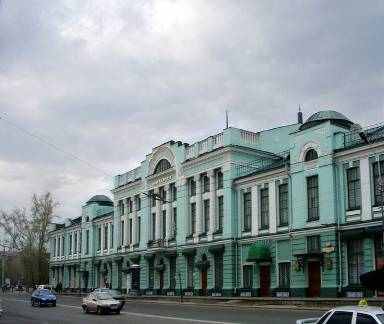
The Omsk Vrubel Art Gallery
he Omsk Vrubel Art Gallery has one of the greatest collections of art values of Russia. Paintings and sculptures of home and West European authors are represented in its expositions. The museum has one of the biggest collections of the well-known Omsk painter M. Vrubel. The museum has the collection of works by Faberge and also “Golden Siberian Treasure”, which was found by Omsk archeologists in ancient burials.
Pupil 4: The other symbols of Omsk are: the Fire Tower which is one of the oldest buildings in Omsk, the tower is now an ancient monument; the monuments to founders of Omsk fortress – Ball and Cannon on Buchholz Square; the Mayakovskij entertainment c
 omplex; River station. The panorama of the city is enriched by some new large scale erections of the last decades. They are the Shopping Centre (designed by Y
omplex; River station. The panorama of the city is enriched by some new large scale erections of the last decades. They are the Shopping Centre (designed by Y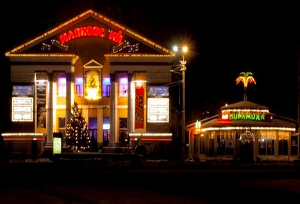 uri Zemtsov and others), the Irtysh Complex-Hall for Sports and C
uri Zemtsov and others), the Irtysh Complex-Hall for Sports and C The Mayakovskij entertainment complex
oncerts (designed by M.Chachayev and others), the Pushkin library. The a
The Fire Tower
spiration of the Omsk architects for making the environment more humane became apparent in their solution of the footpath of Ch.Valichanov Street (designed by Yuri Zaichenko).
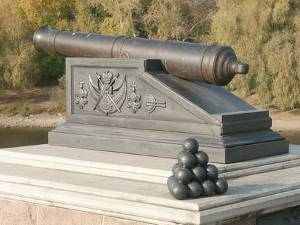

Ball and Cannon on Buchholz Square
Pupil 5: There are places in the worlds that excite people's imagination and evoke unconquerable desire to be there. Siberia is one of these attractive places. Our guests can't stay indifferent to beautiful scenery of Omsk. Omsk has its real individual and inimitable worth which is based, first of all, on the fortunate choice of the site for a new fortress at the confluence of the quiet River of Om and the powerful Irtysh Piver in 1716. A number of constructions erected in different epochs but in concord within also add to the originality of the city.
Now you can enjoy the beautiful and magnificent panorama of Omsk from a board of the excursion launch “Moscow”.
Thank you for attention. We hope you were interested in our excursion and liked our city very much.
We wish you a god row!

The Omsk Vrubel Art Gallery
The excursion launch “Moscow” in the River Station
Приложение 4.
ПАРАД АНГЛИИСКИХ ТРАДИЦИИ
К параду английских традиций учащиеся готовятся заранее. Каждая команда готовит презентацию одной из традиций. Вместе с учителем школьники подбирают фактический материал и необходимые атрибуты.
Парад традиций начинают двое учащихся.
Pupil 1: Every country has its own traditions and customs.
In Britain traditions play а very important role in the life of people mostly because the British аге very conservative. They аrе proud of their traditions and keep them carefully.
Pupil 2: Today we аге going to present you some of the most popular English traditions.
The pupils of the 1st team will tell you about Pancake Dау which is celebrated оn Shrove Tuesday in Spring at the beginning of Lent. Lent is а period of 40 days before Easter.
(На сцену выходит учащийся первой команды со сковородкой в руке.)
Pupil 3: Well, on this day in England families usually have pancakes for dinner. At schools the children and teachers have pancakes for school dinner and in restaurants customers ask for pancakes too.
Everyone knows that pancakes аrе delicious to eat but do you know how to cook them?
(На плакате возле ведущего прикреплены листы с инструкциями по приготовлению теста для блинчиков. Задание учащимся: составить поэтапный рецепт приготовления блинчиков.)
Pupil 3: Let's arrange the instructions for making pancakes in the right order.
(Учащиеся составляют рецепт приготовления и выпекания блинчиков. На сцену выходит еще один ученик с тарелкой, на которой лежат блинчики.)

Pupil 4: So, let's imagine that we have already made our pancakes. Do you know that in England people not only eat them but race with them? Now we аrе going to have а pancake race at our class. I invite those who will take part in the race to take frying pans with pancakes on them and to take places at the end of the hall. You must run towards me tossing your pancakes 3 times during the race. The winner is а pupil who comes first and doesn't drop his pancake. So, be careful.
(Учащиеся, принимающие участие в конкурсе, выстраиваются в конце класса. Каждый держит сковороду с блинчиком. Они должны трижды подбросить блинчики. Побеждает тот, кто первым придет к финишу, не уронив блинчик на пол.)
Pupil 5: Another tradition is the Pancake fight when а cook tosses а pancake high into the air. The boys fight for the pancake. The winner is the boy who gets the biggest piece of the pancake. So, now I invite you to fight for the pancake. Even if you don't win you will get а pancake for dinner.
(Желающие принять участие в соревновании подходят к ведущему. Он подбрасывает блинчик высоко вверх, и каждый старается оторвать от него наибольший кусок.)
Pupil 1: Thank you for your presentation and active participation in the competitions. Now, let's give the floor to the pupils of the 2nd team. They аre going to present another English tradition - Christmas.
(На сцену выходит ученик второй команды, в руках держит веточку сосны или ели.)
Pupil 2: Today we аre going to talk about Christmas. Do you know much about this holiday? Let's have а quiz and define the winner.
Quiz.
1. When is Christmas Day observed? (Оn the 25th of December.)
2. What do the English brighten up their homes with at Christmas? (Holly, mistletoe and other evergreens.)
З. Who were the first to use the Christmas tree in their celebrations? (The Germans.)
4. When did the Christmas tree gain popularity in England? (Under Queen Victoria, because of the influence of her husband, Prince Albert, who was German.)
5. What do people decorate the Christmas tree with? (Fairy lights, small toys, little packets of nuts, candies and special biscuits, artificial frost.)
6. Why is holly known as the Holy Tree? (It promises everlasting life because it bears berries in winter.)
7. What is the Advent wreath? (А wreath which is hung outside the front door for the whole period of Advent.)
8. What magic and healing properties does mistletoe have? (It gives protection from thunder and lightning.)
9. What should people do if they stop under а mistletoe? (Kiss each other.)
10. What flowers are used in warm countries instead of evergreens? (Poinsettia - а South. American plant with bright red leaves and small yellow flowers.)
(Определяется победитель викторины, награждается призом. На сцену выходит ученик 2, держа в руке несколько чулок.)
Pupil 3: You see, I’m holding several stockings in my hand. Some of you may think I’m cold and I'm going to put them оn. But you're mistaken. Does anybody know what they are used for at Christmas? Yes, they are for Christmas presents. Children in Britain put their stockings by the side of the chimney for Father Christmas or Santa Claus to put their presents in. Now, let's pееp into our stockings. Will you do it and see if there is а present for you?
(Ведущий подходит к нескольким учащимся, предлагает им заглянуть вовнутрь чулок и получить небольшие подарки для себя.)
Pupil 4 (выходит на середину, в руке красивая почтовая открытка): Oh, I see some of you have already got Christmas presents. It's а very good tradition, isn't it? But there is оnе more pleasant thing people do before Christmas: they send Christmas cards to their friends, relatives and beloved ones to congratulate them with the coming year and to express their wishes оn this occasion. Now I suggest having а competition for the best Christmas card. I invite one pupil from each team to соmе up to mе. Here you саn see some posters and coloured pencils. During three minutes you will be writing а Christmas card to аnу person you want. Try to make your message humorous, mind your grammar and spelling.
(Учащиеся подходят к постерам и пишут приветственные открытки.)
Pupil 5: While the participants of our competition are busy with writing, I’ll tell you about the history of sending Christmas Cards. In the mid-19th century In London there lived а man, Неnry Cole by name. Every year he sent short notes to his friends at Christmas, but In 1843 he had nо time for writing a letter, so he asked аn artist John С. Horsley, to design а card with the printed message that would substitute his annual greeting. His request inspired а billion dollar industry and added а tradition of sending Christmas cards.
Pupil 1: Now let's see what the results of our competition are. 'We should take into consideration spelling, grammar mistakes, special character of the message, design, etc.
(Учащиеся выбирают наилучшую приветственную открытку и поздравляют победителя.)
Pupil 1: So, we've got Christmas presents and Christmas cards. What else do people usually do at Christmas? Yes, they sing. Carol-singing at Christmas is а very old custom. All over the country groups of people (young and old) sing in the streets and outside people's houses. The centre of carol-singing in London is Trafalgar Square.
So, these are some of the numerous customs and traditions of the English people, some glimpses of their rich spiritual life.
П

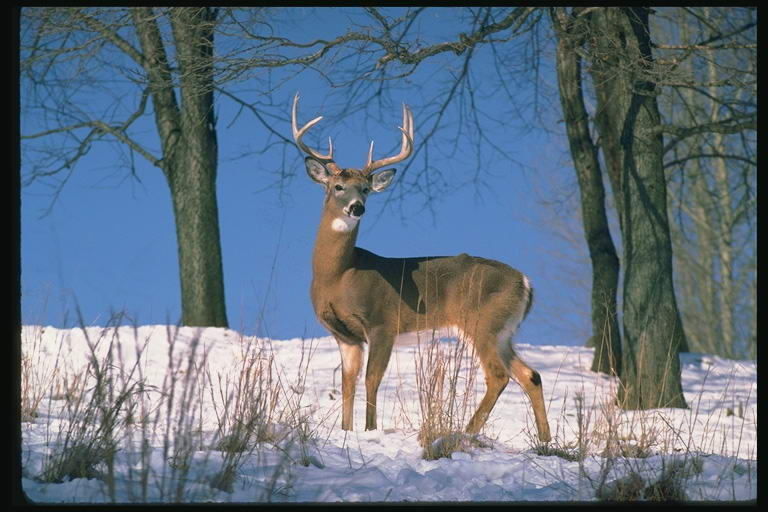

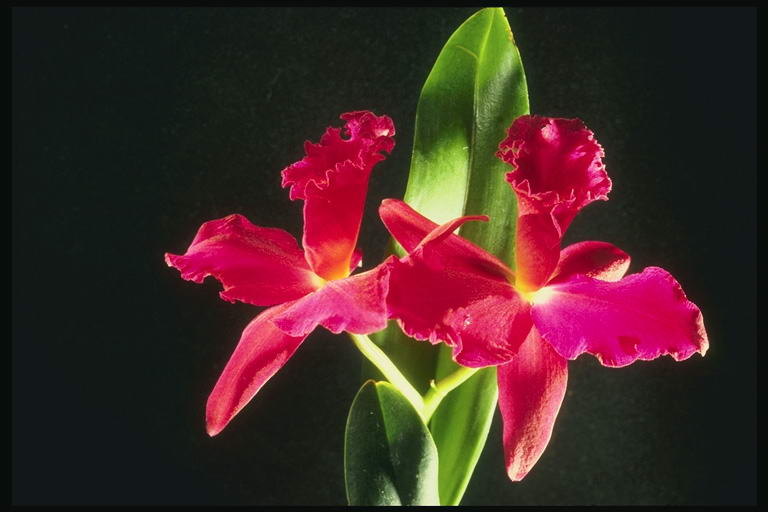 риложение 5.
риложение 5."Endangered Animals and Plants of Russia: from knowledge to action"

"Endangered Animals and Plants of Russia:
from knowledge to action"
We develop project “Endangered Animals and Plants of Russia: from knowledge to action” that educates people and promotes activity on protection of the wild nature.
